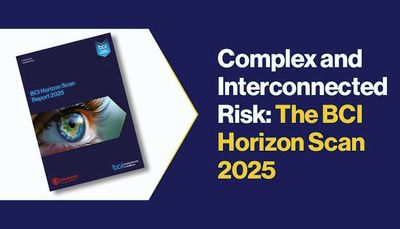The Business Continuity Institute (BCI) in association with Conducttr, has published its Horizon Scan report 2025, the eagerly anticipated annual study analyzing the top risks and threats that organizations have faced over the past 12 months, and those that are expected to sit at the top of the agenda over the coming years.
Organizations are facing risks and disruptions that are more complex and interconnected than ever before, spanning digital, environmental, operational, and human dimensions, often occurring simultaneously and compounding one another.
Along with cybersecurity threats, technological failures, climate-related events, and supply chain vulnerabilities these all have the potential to disrupt operations, affect service delivery, and erode stakeholder confidence.
The report examines these trends, combining findings from both quantitative survey data and qualitative interviews with practitioners on the front lines of business continuity and resilience. Their insights highlight that efforts towards improved response measures and better compliance should be considerate of the health and safety of the workforce.
Safety and IT
In the past 12 months safety incidents and IT-related disruptions rank very highly, a trend that has continued for the past five years. Safety incidents come top, closely followed by cyberattacks, fraud/attempted fraud, security incidents, and IT and telecom outages. Interestingly, extreme weather is the single largest cause of disruption over the past 12 months for the first time since 2017.
Looking at the next 12 months, the top five concerns also have a distinct technology flavour. In order, they are: cyberattacks, extreme weather events, IT and telecom outages, data breaches, and third-party failure / critical infrastructure failure.
This mix of disruptions have a broad impact, affecting operational performance, staff morale and customer experience. Consequences affect both internal and external stakeholders, with growing concerns over staff mental health.
The near future outlook
The future threat landscape is a complex combination of digital challenges, climate risk and geopolitical uncertainty. In many cases, the adoption of digital solutions represents both an opportunity and a potential risk for organizations. The top concerns for organizations over the next five to 10 years are cyber security: 63.6%, climate risk: 40.7%, the role of AI: 30.5%, geopolitical changes: 28.8%, and supply chain issues: 26.3%.
Trend analysis
Trend analysis remains a key tool for understanding emerging threats and guiding resilience planning. Just under half of organizations conduct trend analyses by a central corporate function (47.9%), with 23,5% having a decentralized approach across departments. A fifth (21.1%) don’t conduct these at all.
To conduct trend analysis, organizations rely on a combination of internal assessments and external insights to inform their risk landscape understanding. Interpersonal interaction remains a valuable option to practitioners. Internal risk and threat assessments came in at 87.2%, with external reports and industry insight (such as this report) a close second (75.2%). In the interpersonal interaction bucket come participation in industry events and conferences at (55.6%) and collaboration with peers at 52.1%.
The report also covers some of the legislation approaches – the relationship of BCM programmes to ISO 22301, the benefits of ISO 22301 Certification, and takes a look at investment levels in business continuity & resilience programmes.
Belen Santa-Olalla, Chief Creative Officer at Conductrr, commented, ‘We are proud to support the BCI Horizon Scan Report 2025. Its findings echo what we see every crisis: resilience depends on people, not paperwork. When pressure rises, it is human clarity, confidence, and connection that carry organizations through. That is why we focus on helping teams rehearse real situations in safe, authentic and realistic ways. This report is a reminder that preparation only becomes powerful when people are given space to practise, learn, and grow together.’
Download the report
